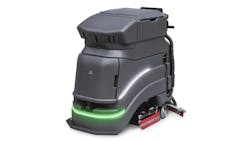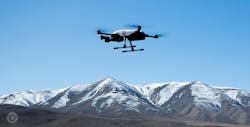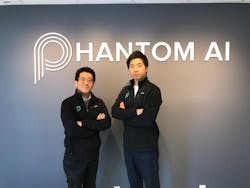Cincinnati/Northern Kentucky Airport adopting robots for continuous floor scrubbing operations
In this week’s roundup from the Association for Unmanned Vehicle Systems International, which highlights some of the latest news and headlines in unmanned vehicles and robotics, a major airport embraces autonomous floor-scrubbing robots, Iris Automation launches a new 360° detect-and-avoid system for unmanned aerial vehicles, and Phantom AI raises $22 million for autonomous driving system development.
Cincinnati/Northern Kentucky International Airport to use robots to autonomously clean airport 24/7
The Cincinnati/Northern Kentucky International Airport (CVG) has announced that it will use floor-scrubbing robots to autonomously clean the airport 24 hours a day, seven days a week.
CVG says that it will be the first airport in the United States to use the Avidbots Neo floor-scrubbing robot.
“At CVG, we aim to embrace what’s next in all that we do,” says Candace McGraw, CEO of CVG Airport, via WKRC Local 12.
“Introducing new technologies to elevate the passenger experience is critical to our business. In the challenging and uncertain times we find ourselves, making sure our facilities are safe and clean is our top priority, so Neo has been a great asset to our team to ensure a high standard of cleanliness is met.”
The only fully autonomous floor-scrubbing robot on the market, Avidbots Neo responds and adapts to its environment using a combination of advanced AI, cameras, and 3D sensors. The robot can operate for six hours on a single charge.
“CVG is one of the world’s most innovative airports, deploying the latest technologies to deliver the very best passenger experience, so we aren’t surprised they are the first airport in the U.S. to deploy the Avidbots Neo floor-scrubbing robot,” says Faizan Sheikh, CEO and co-founder of Avidbots.
“Neo works 24/7 to keep CVG’s facilities spic and span, ensuring a safe and healthy environment for airport visitors, passengers and staff.”
Iris Automation launches first onboard DAA system with 360-degree radial field of view for UAS
Iris Automation has launched Casia 360, the first onboard detect-and-avoid (DAA) system with a 360-degree radial field of view to enable commercial beyond visual line of sight (BVLOS) operations for UAS.
When equipped with Casia 360, a UAS can see and react to the aviation environment around the aircraft, as the DAA system detects other aircraft in all directions. Using computer-vision algorithms, Casia 360 classifies the aircraft and makes intelligent decisions about the threat they may pose to the UAS, before triggering an alert to the pilot in command and automating maneuvers to safely avoid collisions.
“Casia 360 allows a drone to have a complete sense of its surroundings so it can avoid potential collisions from any direction,” explains Iris Automation CEO Alexander Harmsen.
“We developed this technology based on feedback from our customers and regulatory bodies around the world. It enables drones to be used for an even greater range of long-distance use cases and saves money, increases safety and unlocks applications across multiple industries: railway, energy sector, utility powerline inspections, package delivery, and life-saving search and rescue operations.”
A combination of both hardware and software that is lightweight, low power and small in size, Casia is a low SWaP system made up of two onboard controllers and five long-range optical cameras that provide a 360-degree field of view. The software is packaged in a self-contained embedded supercomputer that works with the machine vision cameras onboard.
The Casia technology has been tested through real-world test flights and mid-air collision scenarios flying a number of different manned aircraft against UAS in more than 12,000 real-world encounters and more than 50,000 encounters in simulation. Currently being flown by dozens of customers across 12 countries, Casia holds BVLOS regulators in the U.S., South Africa, and Canada.
Autonomous driving platform developer Phantom AI raises $22 million
Autonomous driving platform developer Phantom AI has raised $22 million in Series A financing, bringing its total capital raised to date to $27 million.
With a goal of democratizing the use of driver assistance and safety technologies to reduce crashes, save lives and make driving more enjoyable, Phantom AI, which was founded in 2016 by lead engineers from Tesla’s and Hyundai’s Advanced Driver Assistance Systems (ADAS) teams, will use this latest round of funding to accelerate product development while scaling operations in Europe and Asia.
The company is working with several automakers, a truck OEM and multiple European and Asian tier 1 suppliers.
“We founded Phantom AI to fundamentally change the economics of ADAS by developing modern software-based solutions that are high performing, cost effective, and infinitely flexible and customizable,” explains Hyunggi Cho, co-founder and CEO of Phantom AI.
“To the automakers frustrated with the lack of options in computer vision technologies—Phantom AI is here to help. We are thrilled to bring our AI-based perception technology, including computer vision, sensor fusion and control capabilities to market, and to have the support of our new investors to help us accelerate production globally.”
The financing round was led by Celeres Investments, who was joined by Ford Motor Company and KT (Korea’s largest telco). Existing investors Millennium Technology Value Partners and DSC Investment also participated in the round.
“With over 1.3 million fatalities resulting from traffic accidents every year, we believe a lot more can be done with computer vision and ADAS technologies to help protect drivers, pedestrians and cyclists and property,” says Ray Cheng, partner at Millennium.
“Phantom AI’s deep domain expertise in AI and mission-critical automotive systems has led them to building an advanced computer vision sensing platform with industry-leading performance. Phantom AI is able to commercialize its platform at compelling price points that can drive mass market adoption as OEMs look to add new safety features to their new designs.”
Compiled by Brian Sprowl, Associate Editor, AUVSI
Share your vision-related news by contacting Dennis Scimeca, Associate Editor, Vision Systems Design


